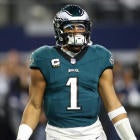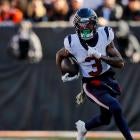It's become understood that wide receivers can take two or three years to have success in the NFL. That's why the "third-year" breakouts became a thing and it's why some refuse to give up on guys like Corey Davis and DeVante Parker. But what about when a rookie receiver hits? Can we expect the same growth?
A.J. Brown, Terry McLaurin and DK Metcalf all finished 2019 as top-30 receivers and their efficiency was something to behold. Brown's 12.5 yards per target were the third best mark of all time and nearly 2 yards better than the second-best rookie ever (Randy Moss). McLaurin and Metcalf both averaged better than 9.0 YPT (as did Deebo Samuel), something only 20 rookie WRs had ever done before last season (minimum 80 targets).
So what does this mean for their 2020? It's blurry at best.
Since 2015, four other rookie receivers have averaged at least 9 yards per target with at least 80 targets. Michael Thomas, D.J. Moore and Cooper Kupp have all turned into studs while Keelan Cole fell almost completely off the map. Cole is the only UDFA on the list, so maybe that's enough to throw his example out. Thomas and Moore both saw a spike in their volume the following year, but a dip in their efficiency. Kupp was even better in his sophomore campaign (10.3 YPT) but injuries cost him half the season.
For Brown, Samuel and Metcalf, I'm worried about how much the volume can go up. They're in run-heavy offenses, and Metcalf still has to battle Tyler Lockett for targets while Samuel cedes targets to George Kittle. Any efficiency regression will be hard for them to overcome without an injury or change in offensive philosophy.
McLaurin doesn't have the same volume concerns. He just needs Dwayne Haskins to improve as a passer. McLaurin was far more productive with Case Keenum under center. The nice thing is, rookie quarterbacks are generally terrible as passers and we should expect Haskins to improve. That's a big part of why McLaurin is in my top-12 and atop this 2019 class heading into 2020.
One final note is that you'll notice all of the receivers mentioned about rank higher in my non-PPR projections than PPR. That's because I still expect them to be above-average in efficiency even if they regress.























